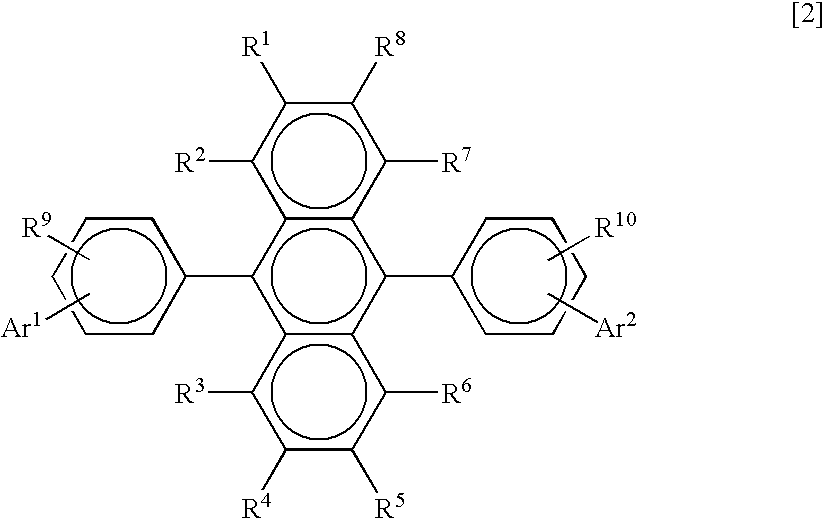Organic electroluminescent device
a technology of electroluminescent devices and organic materials, which is applied in the direction of discharge tube luminescnet screens, sustainable buildings, natural mineral layered products, etc., can solve the problems of reducing color reproducibility, chromaticity control, and affecting the quality of products, so as to achieve easy color adjustment and high luminous efficiency
- Summary
- Abstract
- Description
- Claims
- Application Information
AI Technical Summary
Benefits of technology
Problems solved by technology
Method used
Image
Examples
example 1
[0123] A 25 mm×75 mm and 1.1 mm thick glass substrate with an ITO transparent electrode (anode) (supplied by GEOMATEC CO., LTD.) was subjected to ultrasonic cleaning in isopropyl alcohol for 5 minutes and then subjected to UV ozone cleaning for 30 minutes.
[0124] The cleaned glass substrate with transparent electrode lines was fitted to a substrate holder of a vacuum vapor deposition apparatus. First, a 60 nm thick film of N,N′-bis(N,N′-diphenyl-4-aminophenyl)-N,N-diphenyl-4,4′-diamino-1,1′-biphenyl (to be abbreviated as “TPD232 film” hereinafter) was formed on the surface thereof on which the transparent electrode lines were formed so as to cover the above transparent electrode. The TPD 232 film functioned as a hole-injecting layer.
[0125] The formation of the TPD232 film was followed by formation of a 20 nm thick film of 4,4′-bis[N-(1-naphthyl)-N-phenylamino]biphenyl (to be abbreviated as “NPD film” hereinafter) on the TPD232 film. The NPD film functioned as a hole-transporting la...
example 2
[0131] A device was fabricated by the same method as in Example 1 except that a compound represented by formula was used instead of CBP.
[0132] The above device had a luminance of 100 cd / m2 and an efficiency of 13 cd / A at a DC voltage of 7.5 V as an initial performance. Light from the device has CIE1931 chromaticity coordinates of (x,y)=(0.293, 0.282) and was white.
example 3
[0133] A device was fabricated by the same method as in Example 1 except that a compound represented by formula
[0134] as a host compound and a compound represented by formula [36] as a dopant compound were used instead of formulas [31] and [32].
[0135] The above device had a luminance of 100 cd / m2 and an efficiency of 16 cd / A at a DC voltage of 7.3 V. Light from the device has CIE1931 chromaticity coordinates of (x,y)=(0.292, 0.280) and was white.
PUM
| Property | Measurement | Unit |
|---|---|---|
| electron mobility | aaaaa | aaaaa |
| hole mobility | aaaaa | aaaaa |
| thickness | aaaaa | aaaaa |
Abstract
Description
Claims
Application Information
 Login to View More
Login to View More - R&D
- Intellectual Property
- Life Sciences
- Materials
- Tech Scout
- Unparalleled Data Quality
- Higher Quality Content
- 60% Fewer Hallucinations
Browse by: Latest US Patents, China's latest patents, Technical Efficacy Thesaurus, Application Domain, Technology Topic, Popular Technical Reports.
© 2025 PatSnap. All rights reserved.Legal|Privacy policy|Modern Slavery Act Transparency Statement|Sitemap|About US| Contact US: help@patsnap.com



